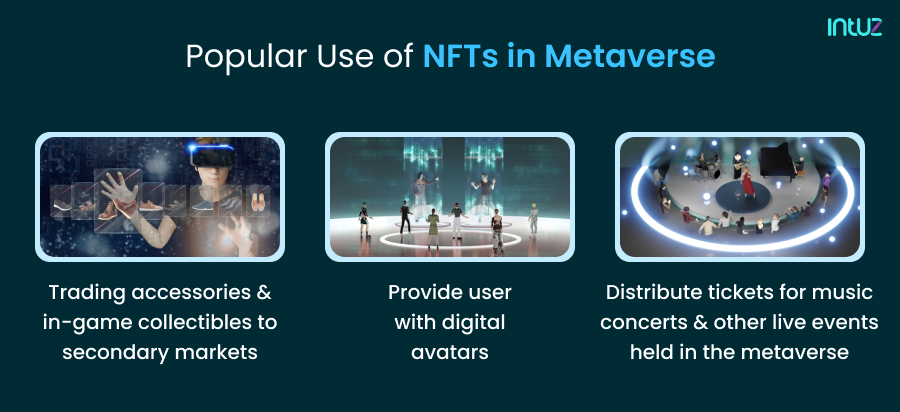
Metaverse is the new buzzword in today’s technological sector. It enables the users to interact and engage in multiple activities like gaming, entertainment, or business through a virtual world. The Metaverse is essentially considered the future of social media. As a result, more people have started taking an interest in the Metaverse. Businesses also see it as an opportunity to capture the emerging market space. Interestingly, the platforms available on Metaverse only allow transactions through cryptocurrencies. Users can use cryptos to buy Metaverse resources like NFTs and digital real estate, and apart from that, IoT has a major role in enabling Metaverse functioning.
“Users can use cryptos to buy Metaverse resources like NFTs and digital real estate, and apart from that, IoT has a major role in enabling Metaverse functioning.“
-Patrick R
Metaverse is a virtual 3D world that offers users a real and exciting digital experience. The Metaverse concept is still new, and various companies are looking at innovative ways to develop this technology. However, knowing the basic concept behind the technology, everyone comprehends its significance in the future. That is why many companies are investing and devoting their time to discovering ways to help them promote their business and products in the Metaverse.

NFTs play a substantial role in the metaverse. NFTs are cryptographic tokens representing a user’s ownership of digital assets like digital art, painting, signature, and more. NFTs were originally formed to trade digital assets. But its functioning and concept became extremely popular, making it workable across diverse use cases.
In the Metaverse, NFTs integrate with VR and AR technology and enable the regulation of the whole space. It means NFTs can represent ownership of all digital assets in the Metaverse, such as virtual avatars, in-game assets, and digital real estate. Other than that, the users can leverage NFTs to explore and purchase digital products of their choice in the Metaverse.
The role of NFTs in the Metaverse is integral. From purchasing to owning digital assets, NFTs have several utilities in the Metaverse. NFTs essentially work as real-world objects in the Metaverse. They enable the tokenization of assets and offer great viability in blockchain games, making them hugely popular in this space. Apart from it, they are used to:
- Provide the users with access to their digital avatars.
- Distribute tickets for music concerts and other live events held in the Metaverse.
- Trading accessories and in-game collectibles to secondary markets.

IoT can be termed as the foundational infrastructure for a Metaverse. Metaverse is a large space that requires massive infrastructure to host its constituent technologies. It includes connecting multiple physical devices and networks to collect and synchronize data. Hence, IoT is the fundamental power to make it happen for the users.
Through the IoT ecosystem of connected objects and entities, IoT objects capture synthetic data to create visual, auditory, and experiential sensations that are “real-like” in the Metaverse. For instance, human body information like the movement of the head to the movement of hands and more can be imitated to create realistic experiences for users.
Other than that, as IoT will enable the networks to merge and project a single visual display through the Metaverse, businesses would be able to market their products even better. By analyzing the location of any user (with their consent), the device would be able to provide personalized offers to users from nearby shops.
In addition, the biggest advantage of IoT-connected networks through Metaverse is the verification and authenticity of NFTs. By pairing the world of NFTs and Metaverse together with IoT hardware, a more sophisticated and secure system for the Metaverse can be established.
Why Are NFTs the Future?
NFTs can transform the way users socialize with each other and interact with traditional social media paradigms. Besides, NFTs are the major components that make transactions in the Metaverse possible. A critical aspect through which businesses would integrate more digital assets into the Metaverse is play-to-earn games. These games enable higher engagement among the players and empower users to earn the benefits of trading and in-game resource lending.
The process would become straightforward with the use of NFTs, and a more fair and transparent system could be achieved. Besides that, different businesses can use their NFT avatars to interact with targeted audiences and make them interested in their products and services. Rather than making a text or video conversation, the NFT avatars would enable the users to interact with the brand more effectively without disclosing their real-life identities. Hence, NFTs are crucial for a Metaverse and will surely shape the future of the Metaverse for good.

It might be clear from the information that NFTs are essential in a Metaverse. Now let us discuss how they can benefit businesses. The three most vital ways through which NFTs may benefit businesses are:
- Help Reach a Global Audience: NFTs and virtual products offer a great way to reach out to a broader audience base through their use. They help promote a brand by providing a digital version of a product and making the users familiar with the real product. NFTs, too, offer a uniform way of selling and buying products virtually in the Metaverse without converting into local currencies and thus engaging a global audience base.
- Trading of Virtual Products: In the Metaverse, NFTs play an important role in the trade and exchange of digital assets or virtual products. All the transactions that happen across the Metaverse are conducted through the NFTs. They allow users to interact and engage with one another and also make sales and purchases of digital assets in the Metaverse.
- Transfer of Ownership: Similar to real-life, the brands in the Metaverse have the ability to launch their NFTs and enable people to invest in them. As the transfer of ownership is regulated through NFTs, users can easily trade off their digital products with hassle-free solutions. NFTs are great for trading gaming collectibles while retaining original ownership.
A major appeal of the Metaverse is the fact that it offers a platform for developers to create and interact with digital assets through NFTs. However, this system is still in its early stage and needs development to make it workable for all. IoT is a tremendous technology that can make this happen using its property of connecting different devices and networks. When leveraging IoT and its components, a decentralized NFT marketplace can be deployed and seamlessly integrated into the Metaverse marketplace. Also, the creation and minting of digital avatars can be done.
The role of IoT in the development of Metaverse and NFTs is significant. By leveraging the right IoT solutions, the Metaverse can be made simpler and refined, which will invariably cater to a broader audience. It will also allow businesses to promote their products more extensively at a cost-effective price.
- SEO Powered Content & PR Distribution. Get Amplified Today.
- Platoblockchain. Web3 Metaverse Intelligence. Knowledge Amplified. Access Here.
- Source: https://www.iotforall.com/how-do-nfts-and-metaverse-fit-into-iot



